Monorail Vs. Other
We present to you some reasons we think monorail could serve better in many transit realms. While monorail is not perfect for every situation, the following arguments present a strong case for the narrow beamed wonders.
Aesthetics

Heavy Rail / Subway
For the most part, subways are out of the public view, but what about what the passenger sees? Why should transit, an intregal part of life for hundreds of thousands of people be relegated to a dark viewless environment? On the other hand, when heavy rail is elevated, the guideway casts a wide shadow and blocks out much more of the sky.
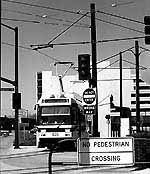
Light Rail (trolley)
Proponents of Light Rail will tell you that overhead rail is ugly, but they don't mention that Light Rail requires a spiderweb of overhead wires with support posts. And when light rail is elevated, it's even more obtrusive with its wide, dark street-producing guideway.
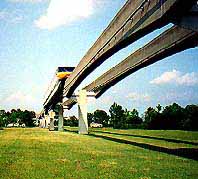
Monorail
The monorail guideway can be constructed to be an enhancement rather than a detriment to the environment. Above is the graceful arched guideway of the Walt Disney World Monorail System. The beam is only 26" wide. Note the small shadow. We feel that aesthetics are important to many people, so we have created a special page devoted to them. Click on Environment Friendly for more "evidence" of monorail friendliness.
Construction
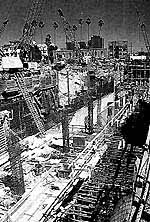
Heavy Rail / Subway
You are looking at the Wilshire/Alvarado Station under construction for the Los Angeles Red line subway. Imagine having a business on this street during years of construction. Yes, this is a street! Imagine trying to get around town. Also, ask any subway contractor about the logistics of moving or replacing underground utilities.
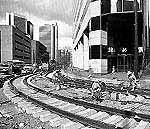
Light Rail (trolley)
While light rail proponents say it's easy to put in rail on the surface, the reality is that businesses always fail along the route. Customers can't access their establishments during the long period of construction. Entire streets and underground utilities must be rebuilt to put in light rail. During light rail construction, there are always businesses that go under because customers can't get to them.
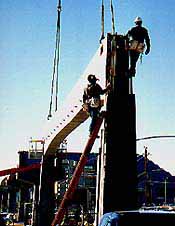
Monorail
Simply put...dig a hole, drop in a pre-built support pylon, truck in the track which was manufactured offsite, lift into place! Monorail beamway can be installed far faster than the alternatives. This is a Las Vegas Monorail beam being put into place. From truck bed to pylons was a matter of a few minutes. The entire system took only seven months to construct. No other fixed rail can be installed as quickly and as disruption-free.
Cost
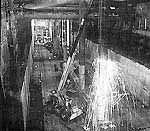
Heavy Rail / Subway
Contractors and rail consultants love heavy rail. It keeps them busy for years and brings in the big bucks. You pay for it Mr. Taxpayer. As if that isn't enough, operational costs of heavy rail are so high that Mr. Taxpayer (you again) have to subsidize it for as long as it operates.
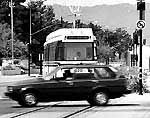
Light Rail (trolley)
Light Rail must have drivers; that costs more. Steel wheels and steel track require constant care. Light Rail doesn't operate at a profit. And what is the cost of human life? Certainly life is more important than the millions taxpayers fork out in lawsuit settlements from tragic Light Rail accidents.
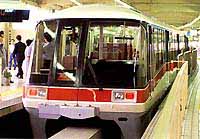
Monorail
While capital costs can be as much as or more than light rail, monorail can turn a profit once built. The Tokyo Monorail (above) is operated by a private business and turns a profit each year. This is unheard of with conventional rail or bus systems. The Seattle Monorail also turns a profit each year.
Efficiency
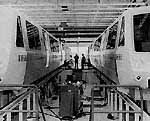
Heavy Rail / Subway
Steel wheels on steel rail grind and wear. Therefore, both wheels and rail require far more care than monorail. This alone makes profit impossible with heavy rail. Frequent vehicle breakdowns during operation also make heavy rail much less reliable than monorail.
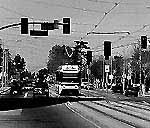
Light Rail (trolley)
If you run in the street, your schedule can be influenced by conditions during peak traffic times. Who wants to abandon their car to get to their destination slower? Once again, steel wheels on steel rails keep the maintenance personnel busy, and more trains are kept in the shop. Frequent accidents also keep trains in the shop.
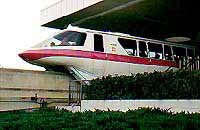
Monorail
Monorails regularly operate at an amazing 99.9% reliability. No other form of transit can touch that number. The rubber tires get little wear running on smooth guideways. Typically, each load tire gets over 100,000 miles of travel before being replaced. Walt Disney World has a total of 12 trains and during peak seasons at least 10 are on the beamway serving passengers 17 hours a day. There are even times when all 12 trains are operating, sometimes carrying over 200,000 passengers a day.
Safety
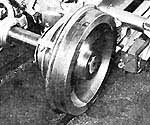
Heavy Rail / Subway
This flanged wheel is what holds conventional rail to the track. It's not much and it sometimes fails. If you don't believe us, look up DERAILMENT under your favorite Search engine. You won't find any monorails there. Obviously, a derailment can affect the safety of a system.

Light Rail (trolley)
This is what was left of a car that was clobbered by a Los Angeles Blue Line light rail train at an intersection. The driver is no more. Light rail normally operates at grade and mixes with automobile traffic. Unfortunately, that's exactly what it does frequently, mixes with traffic. Pedestrians aren't immune either. Interestingly, Light Rail isn't really light. Light refers to its capacity. The train cars are actually heavier than heavy rail. Why? So they can withstand COLLISIONS.
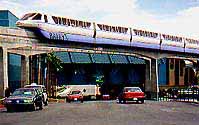
Monorail
Take a good look at this picture. Then tell us what the probability of a monorail ever colliding with an automobile, truck or school bus is. Monorails run on an exclusive grade-separated guideway. The result? Accidents are extremely rare. The way monorails are designed also makes derailments virtually impossible. This is why Monorails have an excellent safety record.
- Page 1: Why Monorail?
- Page 2: What is a Monorail?
- Page 3: Monorail vs. Other
- Page 4: Environmentally Friendly
- Page 5: Cost
